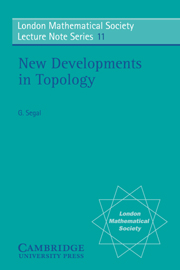Book contents
- Frontmatter
- Contents
- Preface
- 1 Operations of the nth kind in K-theory, and what we don't know about RP∞
- 2 The Pontrjagin dual of a spectrum
- 3 Algebraic K-theory of non-additive functors of finite degree
- 4 Dyer-Lashof operations in K-theory
- 5 Homotopy homomorphisms of Lie groups
- 6 On spherical fiber bundles and their PL reductions
- 7 E∞ spaces, group completions, and permutative categories
- 8 Higher K-theory for categories with exact sequences
- 9 Operations in stable homotopy theory
- 10 Equivariant algebraic K-theory
- 11 On rank 2 mod odd H-spaces
2 - The Pontrjagin dual of a spectrum
Published online by Cambridge University Press: 05 April 2013
- Frontmatter
- Contents
- Preface
- 1 Operations of the nth kind in K-theory, and what we don't know about RP∞
- 2 The Pontrjagin dual of a spectrum
- 3 Algebraic K-theory of non-additive functors of finite degree
- 4 Dyer-Lashof operations in K-theory
- 5 Homotopy homomorphisms of Lie groups
- 6 On spherical fiber bundles and their PL reductions
- 7 E∞ spaces, group completions, and permutative categories
- 8 Higher K-theory for categories with exact sequences
- 9 Operations in stable homotopy theory
- 10 Equivariant algebraic K-theory
- 11 On rank 2 mod odd H-spaces
Summary
Recall, if G is a discrete abelian group and c(G) is its character group, that is,
c(G) = Hom(G, R/Z),
then Pontrjagin duality provides an isomorphism
Hq(X; c(G)) ≍ c(Hq(X; G)).
The aim of this talk is to describe, without proofs, how this duality can be incorporated into generalized homology and cohomology theories and spectra.
Regarding spectra, we work in Boardman's graded homotopy category of spectra Sh* ([5]). We denote the morphisms of degree q (f:A → SqB) by
{A, B}q.
If A is a spectrum and X is a CW complex or a spectrum, Aq (X) and Aq(X) denote the homology and cohomology of X with coefficients in A, respectively.
Let g be the category of discrete abelian groups. We ignore the topology on c(G) so that c: g → g. Recall c takes exact sequences into exact sequences and direct sums into direct products. Hence for any spectrum A, c(A* ()) is an additive cohomology theory on the category of all CW complexes. Therefore by [2], there is a spectrum A′ and a natural equivalence
tA: (A′)*() ≍ c(A*()).
The main results of this talk concern the relation between A and A′ We do not know how to adequately deal with the natural topology on c(A*()). Inconsequence, most of our results on A′ require that we assume πi(A) is finite for all i.
Let S be the sphere spectrum. Choose a spectrum c(S) and a natural equivalence
tS: c(S)*() ≍ c(S*()).
We identify c(S)0(S0) with R/Z via the isomorphism:
c(S)0(S0) ≍ tS c(S0(S0)) ≍ c(Z) = R/Z.
- Type
- Chapter
- Information
- New Developments in Topology , pp. 11 - 18Publisher: Cambridge University PressPrint publication year: 1974

